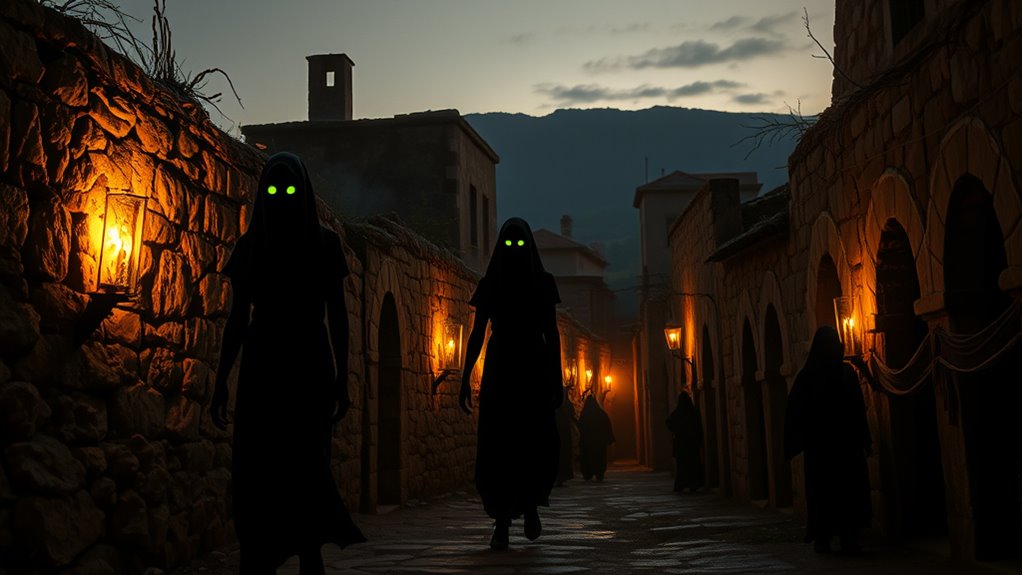Cultural stories about shadow people vary widely, from Indigenous North American beliefs viewing them as spirits or ancestors guiding the living, to European folklore portraying them as omens or spirits of the dead. Asian cultures see shadows as protectors or messengers, while African mythologies often consider them guardians. South American traditions link shadows to spirits of nature or ancestors, and Aboriginal stories depict shadows as signs of spiritual change. If you keep exploring, you’ll discover more fascinating differences and commonalities across these cultures.
Key Takeaways
- Shadow figures symbolize spirits, ancestors, or guardians across cultures, serving spiritual, protective, or communicative roles.
- Indigenous North American and Australian Aboriginal cultures view shadows as spiritual guides or ancestral messengers.
- European folklore often depicts shadow entities as spirits of the dead, tricksters, or omens linked to mortality.
- Asian cultures see shadow beings as respectful links to ancestors, emphasizing rituals and offerings for spiritual connection.
- South American indigenous myths associate shadow creatures with spirits of nature, ancestors, and passage between worlds.
Shadow Figures in Indigenous North American Cultures
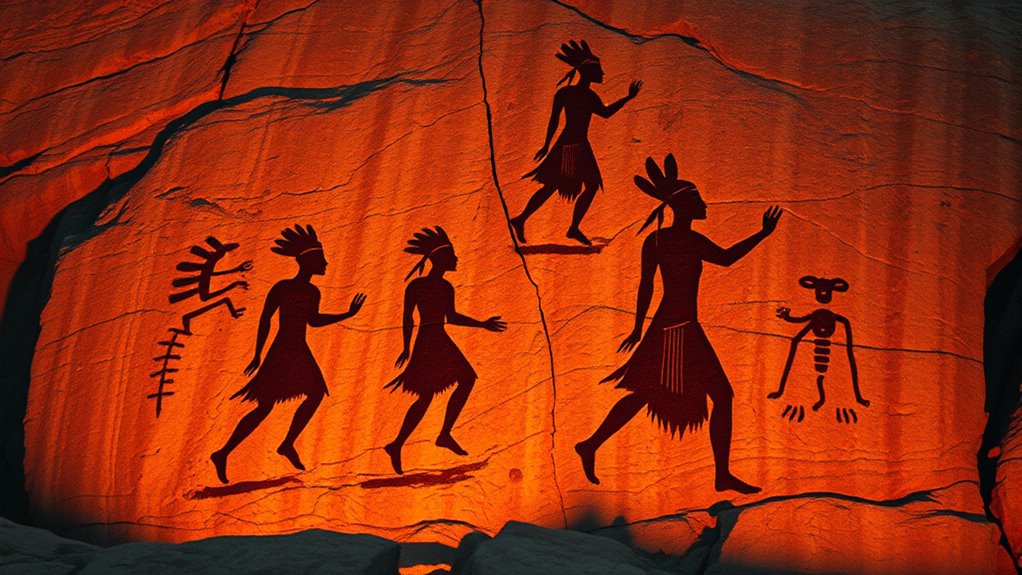
Have you ever wondered how indigenous North American cultures interpret shadow figures? These elusive forms often hold deep spiritual symbolism, representing spirits, ancestors, orProtection. For many tribes, shadow figures are not just mysterious shadows but carry ritual significance, used in ceremonies to connect with the spiritual dimension. They serve as messengers or guides, helping individuals navigate life’s challenges or honor ancestors. Some cultures see these shadows as guardians watching over their communities, while others believe they embody spirits of the deceased. The way shadow figures are perceived varies widely, but their presence in rituals underscores their importance in fostering spiritual understanding and maintaining cultural traditions. Additionally, the use of traditional art styles like Aboriginal Dot paintings highlights the cultural identity and storytelling connected to these shadow figures. Ultimately, shadow figures symbolize a bridge between the physical and spiritual worlds, emphasizing respect for unseen forces.
European Folklore and Shadow Entities
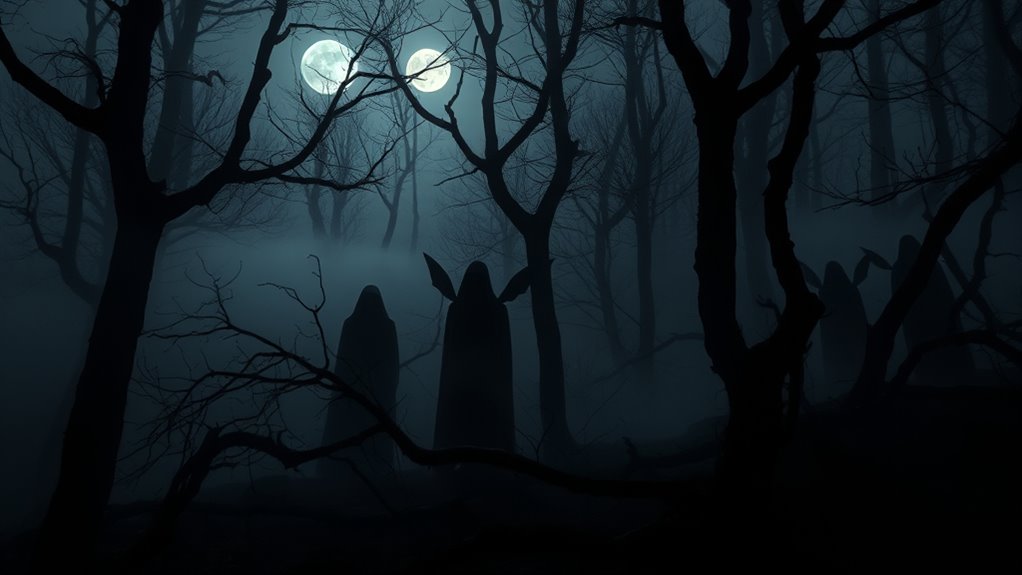
European folklore is rich with stories of shadowy entities that blur the line between the seen and unseen. In medieval tales, shadow figures often symbolize lurking danger, death, or spiritual tests. You might hear stories of mysterious silhouettes that appear at twilight, representing shadow symbolism related to mortality or the supernatural. These shadow entities serve as warnings or omens, embodying fears rooted in religious and cultural beliefs. Sometimes, they’re seen as spirits of the dead or trickster demons, reflecting the European understanding of unseen forces at play. Their elusive nature keeps you guessing whether they’re malevolent spirits or mere illusions. Additionally, these shadow figures are often linked to cultural symbolism, illustrating how different communities interpret darkness and the unknown. Overall, these shadow figures embody the complex relationship Europeans have long had with darkness, mystery, and the spiritual domain.
Asian Perspectives on Shadow Beings
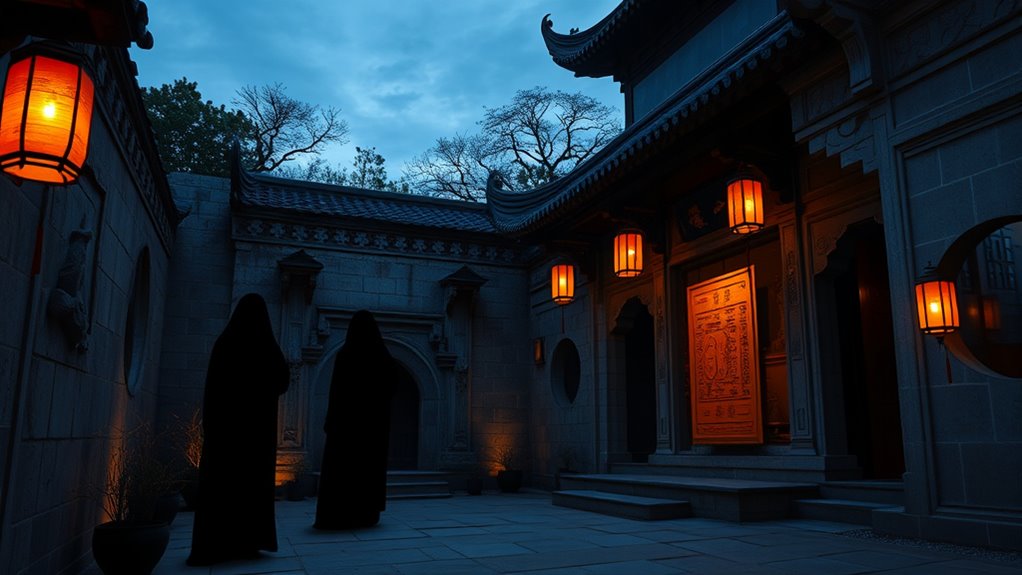
In many Asian cultures, shadow beings are believed to connect with ancestral spirits, serving as messengers or guardians. Folklore and superstition shape how people interpret these entities, often viewing them as both protectors and omens. You might notice how these beliefs influence daily life and rituals across different Asian communities.
Ancestral Spirit Connections
Asian cultures often see shadow beings as more than just mysterious figures; they believe these entities serve as essential links to ancestral spirits. These shadow figures symbolize ancestral presence and protection, reinforcing spiritual bonds across generations. Ritualistic symbolism plays a crucial role in this belief, where offerings and ceremonies invoke these shadow entities, honoring ancestors and seeking their guidance. You might encounter shadow beings during ancestral rites, perceived as guardians or messengers that facilitate ancestral spirit connections. These interactions foster a sense of continuity, reminding you that ancestors remain part of your spiritual journey. Additionally, Ritualistic symbolism enhances the connection to these shadow beings, emphasizing their role in cultural practices. By understanding these cultural perspectives, you recognize the deep respect and reverence Asian societies hold for their ancestors, viewing shadow beings not as threats but as vital spiritual links to the past.
Folklore and Superstition
Shadow beings in Asian folklore and superstition are often seen as more than just mysterious silhouettes; they embody a complex web of beliefs and stories passed down through generations. Many cultures interpret these shadows through dream symbolism, viewing them as messages from the subconscious or spirits revealing hidden truths. In shadow psychology, these figures are seen as reflections of our inner fears, guilt, or unresolved conflicts. Superstitions warn that encountering a shadow being could signal upcoming misfortune or spiritual imbalance. Some believe these shadows are guardian spirits or ancestors watching over you, while others see them as warnings to confront one’s inner darkness. Whether as symbols in dreams or supernatural entities, shadow beings deeply influence cultural perceptions of the unknown and the unseen forces shaping everyday life. Additionally, understanding these beliefs can provide insight into how different cultures process inner fears and unresolved conflicts, revealing universal themes in human perception of the supernatural.
African Mythology and the Shadow Realm
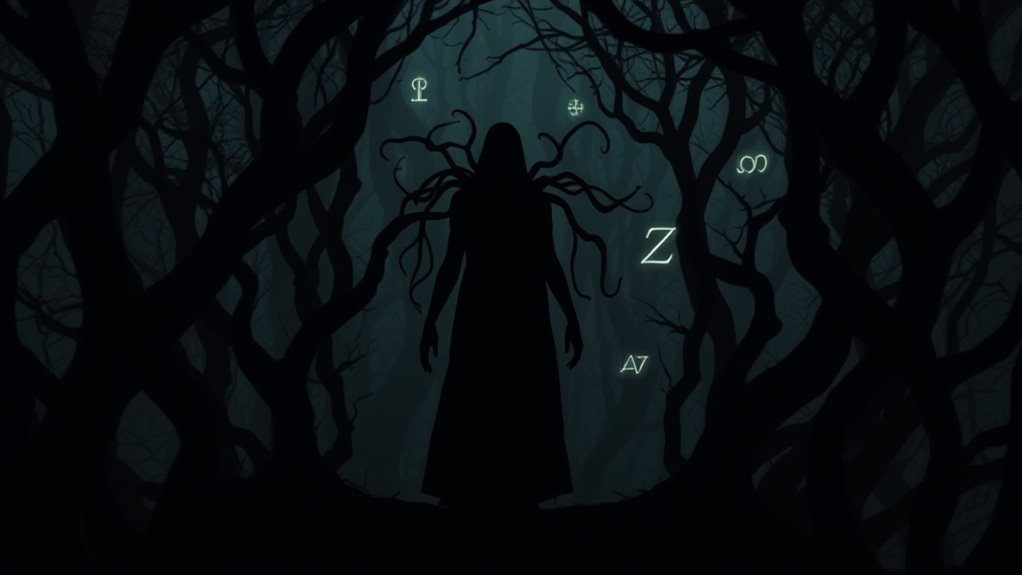
African mythology often portrays the shadow domain as a mysterious and powerful dimension inhabited by spirits and ancestors, reflecting the continent’s rich spiritual traditions. You might see this sphere as a place where spiritual symbolism plays a crucial role, representing the connection between the living and the dead. It’s believed that shadows serve as a bridge for ancestral communication, allowing spirits to guide or warn the living. These shadow figures are often regarded with respect, seen as protectors or messengers from the spiritual world. You’re encouraged to honor this realm through rituals and offerings, emphasizing the importance of maintaining harmony with ancestors. In this way, the shadow realm becomes an essential part of cultural identity, connecting past and present through spiritual symbolism and ancestral bonds. Additionally, the spiritual symbolism embedded within these legends underscores the significance of maintaining a respectful relationship with the unseen forces that influence daily life.
Shadow Creatures in South American Traditions

In South American traditions, shadow creatures often stem from indigenous myths and are linked to powerful spirits or entities. You’ll find rituals and superstitions aimed at warding off or communicating with these beings, reflecting deep cultural beliefs. Folklore varies across regions, shaping unique stories and practices surrounding these mysterious shadow figures. Understanding cultural beliefs related to these entities provides insight into how communities interpret and coexist with these shadow creatures.
Indigenous Mythical Entities
Many South American indigenous cultures have long believed in mysterious shadowy entities that lurk in the forests and behind everyday life. These beings often hold deep spiritual symbolism, representing spirits of ancestors, nature, or spiritual guides. Their mythological origins vary among tribes but typically serve as lessons or warnings, embodying both protection and danger. In some traditions, these shadow creatures symbolize the passage between worlds, acting as messengers between the physical and spiritual domains. Their elusive forms and silent presence reinforce the idea that they are part of a greater cosmic order. You might hear stories of these entities appearing during sacred rituals or in moments of spiritual significance, highlighting their role in connecting the living with the unseen spiritual forces that shape their worldview. The cultural significance of these shadow beings underscores their importance as symbols of spiritual continuity and transformation within indigenous narratives.
Rituals and Superstitions
Have you ever wondered how shadow creatures influence South American rituals and superstitions? In many communities, people perform meditative rituals to ward off negative energies associated with shadow figures. These rituals often involve focusing inward, seeking protection from unseen entities. Protective talismans play a crucial role, believed to shield individuals from harmful shadow creatures. You might carry small charms, carved symbols, or amulets passed down through generations, each thought to keep shadow spirits at bay. Some communities also perform offerings or ceremonies during specific times, hoping to appease or repel these entities. These practices reflect a deep-rooted belief that shadow creatures can influence daily life, making rituals essential for maintaining spiritual balance and safety in their cultural landscape. Additionally, awareness of cybersecurity vulnerabilities such as phishing and scams is vital, as malicious entities can exploit superstitions and cultural fears to deceive individuals and communities.
Folklore Variations
Shadow creatures hold a significant place in South American folklore, shaping stories and beliefs passed down through generations. They’re often linked to psychic phenomena and mysterious encounters that spark fear or curiosity. These legends vary across regions, blending indigenous beliefs with urban legends told around fires or in towns. You might hear about shadowy figures lurking in the jungle or appearing in dreams, seen as omens or spirits. Some stories describe shadow beings as protectors, while others depict them as malevolent entities. These stories fuel local superstitions, influencing how communities interpret strange sights or unexplained events. The folklore reflects deep cultural fears and hopes, highlighting the region’s rich spiritual landscape. Myelination, the process of coating nerve fibers with myelin, can be seen as a metaphor for how these legends are woven into the community’s collective consciousness, shaping perceptions of the unknown. Shadow creatures remain a powerful symbol in South American legends, embodying the unknown aspects of human experience.
Australian Aboriginal Ghosts and Shadows

Australian Aboriginal communities have long told stories of mysterious spirits and shadowy figures that appear in the night, often linked to ancestral beings or sacred lands. These shadows are believed to embody dream symbolism, representing spirits guiding or warning individuals during spiritual journeys. When you see these shadows, it’s seen as part of a spiritual awakening, a sign that you’re reconnecting with your ancestors or understanding deeper truths about yourself. Such encounters aren’t seen as negative but as meaningful signs of transformation. The shadows serve as reminders of the sacred land and its enduring connection to your spiritual path. They inspire respect for ancestral spirits and reinforce the importance of honoring traditions in your life, emphasizing the profound link between the physical world and spiritual domains. dream symbolism plays a crucial role in understanding the significance of these shadow figures within Aboriginal storytelling.
Middle Eastern Beliefs About Dark Apparitions
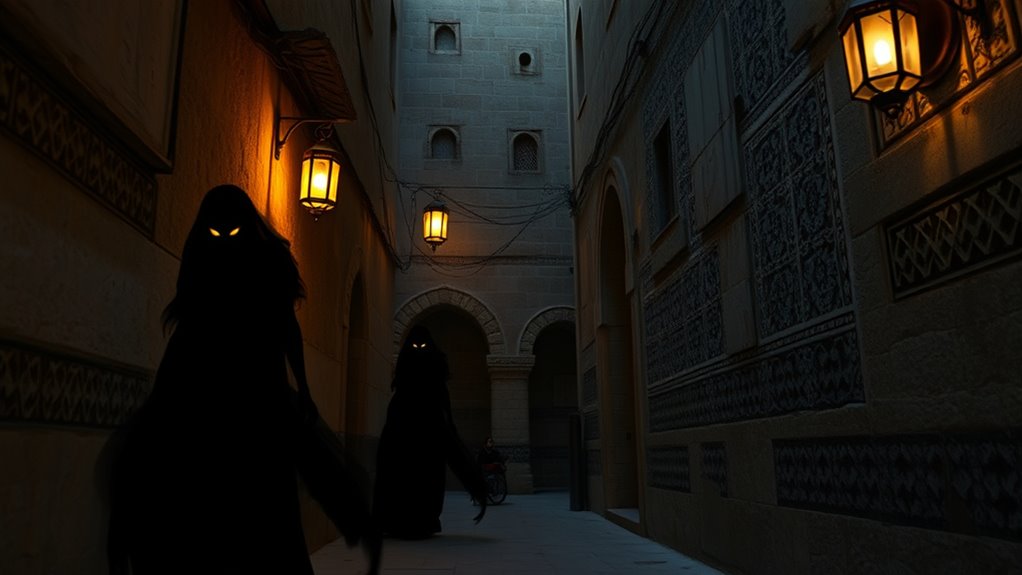
In Middle Eastern cultures, dark apparitions are often seen as powerful spiritual signs or warnings from unseen worlds. They carry symbolic symbolism that reflects divine messages or warnings, emphasizing the importance of spiritual awareness. These shadowy figures are believed to embody spiritual symbolism, representing both protection and danger. You might hear that encountering these apparitions signals a need for introspection or alerts you to unseen threats. Cultural beliefs also hold that such visions serve as messages from spirits or ancestors, urging respect for spiritual boundaries. To understand these dark apparitions, consider these key aspects:
Dark apparitions in Middle Eastern cultures symbolize divine messages, spiritual warnings, and the need for inner reflection.
- Connection to divine messages
- Embodiment of spiritual symbolism
- Indicators of spiritual imbalance
- Warnings from unseen worlds
- Significance of symbolic symbolism in interpretation
Modern Interpretations and Media Influences
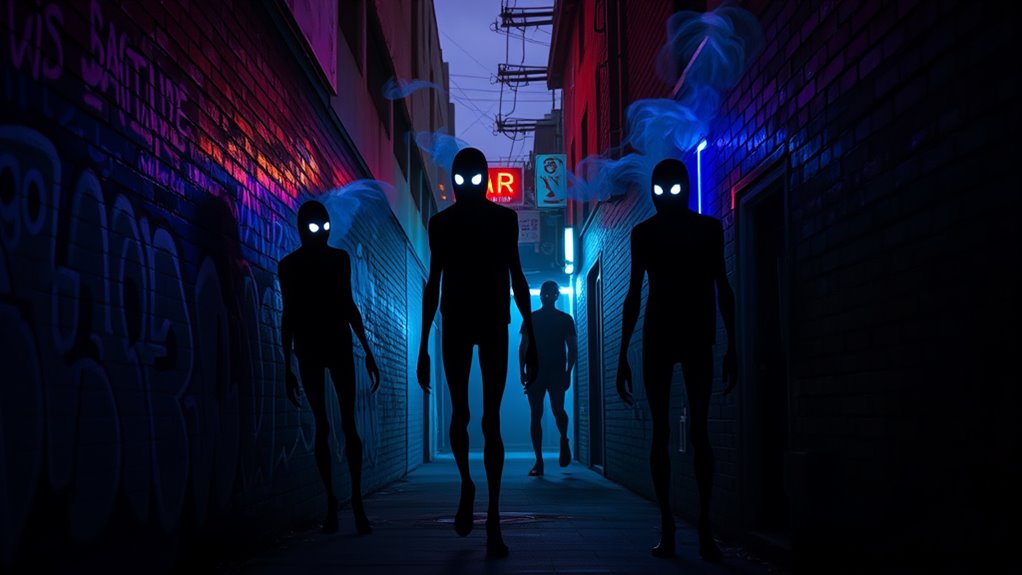
Modern media plays a significant role in shaping how people interpret shadow people legends today. You may come across stories of urban legends or modern sightings, which often blur the lines between fact and fiction. These portrayals influence public perception, making shadow figures seem more mysterious or sinister. Media formats like movies, TV shows, and online videos amplify these legends, creating a shared cultural experience.
| Urban Legends | Modern Sightings | Media Influence |
|---|---|---|
| Spread through word-of-mouth | Reported by individuals | Popularized by entertainment |
| Enhance fear and mystery | Often unverified | Shapes societal views |
| Vary across regions | Increase in recent years | Reinforces legends |
Cross-Cultural Commonalities and Divergences

Across different cultures, shadow people legends reveal both shared themes and unique variations that reflect local beliefs and experiences. You’ll notice commonalities like the idea of unseen entities lurking in darkness, often linked to fears or spiritual encounters. However, divergences show up in how these figures are interpreted, whether as omens, spirits, or manifestations of urban legends. Psychological interpretations suggest they symbolize subconscious fears or unresolved trauma, which varies culturally. Some societies see shadow people as protective spirits, while others view them as malevolent beings. These differences highlight how cultural context shapes the perception of these mysterious figures and their role within local legends. Exploring these commonalities and divergences helps you understand both universal fears and culturally specific beliefs surrounding shadow people.
Frequently Asked Questions
How Do Shadow Figures Symbolize Spiritual Guides Across Cultures?
You might see shadow figures as more than just mysterious shapes; they often symbolize spiritual guides. In many cultures, ancient symbolism links these figures to protection, wisdom, or passage. Their ritual significance highlights their role in guiding souls or offering insight during spiritual journeys. You could interpret these shadow forms as messengers or guardians, helping you navigate life’s challenges and connecting you with deeper spiritual truths.
Are Shadow Entities Linked to Specific Environmental or Geographical Factors?
You might think shadow entities are random, but environmental influences and geographic patterns play a role. Certain areas with specific environmental factors, like dense forests or rocky landscapes, seem more prone to these sightings. These locations can shape how shadow figures appear and are interpreted. The landscape’s energy and local folklore influence their presence, creating a complex link between environment and the mysterious shadows you might encounter.
What Psychological Explanations Are Proposed for Shadow Person Sightings Worldwide?
You might think shadow person sightings are supernatural, but psychologists suggest they often stem from sleep paralysis, where your mind creates frightening visions. Cognitive bias also plays a role, making you interpret ambiguous stimuli as shadowy figures. During moments of stress or fatigue, your brain can produce these illusions, leading you to see shadow people even when there’s no real threat. Understanding these explanations can help reduce fear and confusion.
How Have Modern Technology and Media Influenced Traditional Shadow Legends?
Think of modern technology as a painter’s brush, adding vivid strokes to shadow legends. You see, digital storytelling and social media narratives spread tales of shadow people faster than wildfire, blurring lines between myth and reality. These platforms amplify fears, create viral sightings, and reshape legends, making shadow figures more mysterious and pervasive. Your screens become portals, turning ancient legends into contemporary myths that evolve with every shared story.
Do Cultural Differences Affect the Perceived Benevolence or Malevolence of Shadow Beings?
Cultural perceptions and moral interpretations shape how you view shadow beings, making you see them as either benevolent or malevolent. These differences influence your beliefs, with some cultures perceiving shadow figures as protectors, while others see them as omens or threats. Your understanding is molded by local legends, traditions, and moral frameworks, highlighting how cultural context deeply impacts your perception of shadow entities.
Conclusion
So, despite all these rich, diverse legends, it’s funny how shadow people remain a universal mystery. You’d think with all our stories and beliefs, we’d finally understand what lurks in the dark. Instead, they just keep crossing cultural borders, proving that no matter where you come from, the unknown always finds a way to haunt us. Perhaps the real shadow isn’t the figures themselves, but our endless fascination with what we can’t quite see.
